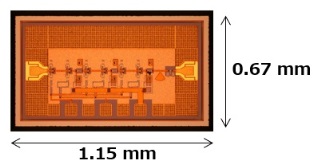
We are the 6G Amplifiers Group from the Devices & Materials Research Center and Mobile System Business Unit. We have been conducting research and development on large-capacity communications using high-frequency signals in the sub-terahertz band. This report introduces the world's first successful beam control using a waveguide aperture array antenna with a narrow pitch of 0.7 wavelengths (0.7 mm) at 300 GHz.
- Details of this technology were presented at 2023 IEEE CAMA (Conference on Antenna Measurements and Applications).
- These array antenna and power amplifier will be exhibited at MWC 2024 (Mobile World Congress), the world's largest mobile industry exhibition, to be held in Barcelona, Spain from February 26 to 29, 2024.
- This work was partially supported by "R&D on THz band ultra high-capacity wireless communications for beyond 5G (JPJ012368C00301)" from the commissioned research by National Institute of Information and Communications Technology (NICT), and "The research and development project for the expansion of radio spectrum resources (JPJ000254)" of the Ministry of Internal Affairs and Communication, Japan.
Background and Challenges
The future world we envisioned as children is slowly becoming a reality. Everything goes in the direction of automation and manpower saving, and technological innovation in how to make people physically far away feel close to them is also remarkable. One of the technical requirements to support this is "communication," which involves sending a large amount of data instantly to another location. Currently, the world is actively conducting research and development for 6G wireless communication systems, which is expected to start in 2030.
Our group is conducting research and development in the sub-terahertz band (100 GHz band or higher), which is considered to be a strong candidate for high-capacity, high-speed communications because it provides a wider bandwidth than existing radio communication frequencies of several GHz. Especially around 300 GHz, there is a possibility of securing a continuous wide frequency range, and therefore, research and development for future communications are being carried out.
However, high-frequency radio waves have an inherent problem of short reach and low wraparound for obstacles, and one solution is beam control by phased array antennas. By emitting a highly phase-controlled signal from the arrayed antenna, the radio wave can be narrowed into a beam and directed in any direction. In phased arrays, the pitch (period) of antenna elements is an important parameter, and to prevent unwanted radio emissions in unintended directions, antennas should be placed at a very narrow period below the wavelength (1 wavelength is 1 mm at 300 GHz).
Development Results
Realization of 0.7 Wavelength Pitch 1x4 Arrays at 300 GHz
We chose 0.7 wavelengths as the target for antenna pitch. This is a value that can suppress unwanted radiation within a beam swing range of approximately ±25 degrees, and an extremely narrow pitch of 0.7 mm for 300 GHz radio waves. As shown in Fig. 1, the prototype 1x4 array includes (1) a waveguide aperture antenna, (2) a microstrip line-waveguide conversion, and (3) a power amplifier chip mounted with flip-chip on an interposer, all of which were successfully fabricated in a small area of 0.7 mm.
In addition, a beam control experiment was conducted on the fabricated waveguide aperture array antenna, and it was possible to measure the beam control of ±10 degrees against 300 GHz radio waves. This is the world's first successful beam control using a 0.7 mm pitch waveguide array at 300 GHz.

Development of Power Amplifiers with 0.7 Wavelength Pitch Size
In MMIC (Monolithic Microwave Integrated Circuit) using InP-based HEMTs (High Electron Mobility Transistors), 10 mW class power amplifier with one side less than 0.7 mm was realized. The chip photograph is shown in Figure 2.

Looking Ahead
This time, we confirmed the feasibility of 300 GHz using a one-dimensional array antenna with a waveguide aperture. In the future, we will develop new structures for miniaturization and two-dimensional arrays with stacks, which are necessary for practical use.
Related links
- Fujitsu Honored with IEEE Milestone for High Electron Mobility Transistor [Fujitsu Global Site](December 18, 2019, Press Releases)
- Towards 6G high-speed communications – Fujitsu develops the world's most efficient J-band power amplifier(February 27, 2023, Technical Topics)